Two Mornings Work
With giants, a love scene, an umbrageous covert and the mysteries of twiggy pea sticks explained.
Saturday.
Today I’m up and out in Front Garden at 5.45 a.m. because this is just the best time for gardening. So many birds here in my umbrageous covert, many of them almost tame now, the Blackbirds, the Robin, and the House Sparrows who, according to themselves, own this gaff.
Umbrageous covert? Where did that come from? Oh, it’s Wordsworth! The Prelude, Book 2.
It was the pastime of our afternoons To beat along the plain of Windermere With rival oars, and the selected bourne Was now an Island musical with birds That sang for ever; now a Sister Isle Beneath the oaks' umbrageous covert, sown With lillies of the valley, like a field; And now a third small Island where remain'd An old stone Table, and a moulder'd Cave, A Hermit's history.
In my umbrageous covert, the Wren is flitting, just visible, like a fairy or a dream-memory of bird-flit. And out of sight, to bring me back to earth, the Wood Pigeons chuntering on in the voice of Timothy Spall in the Brian Clough movie, ‘Love you, baby. Love you, baby.’
I’ve just checked, and it fact what TS says is ‘please, please baby, take me back…’ But that is more or less what the pigeon is saying. It’s the accent. Great movie, even if you don’t like football.
What will I do today? The lovely thing about gardening is you can be as disorganized as you like and you can always find something to do and then to concentrate yourself on. The disorganisation and massive to do list settle easily into tasks that present themselves.
I just walk out of the door and something will say ‘look at me!’
Today it is the big Thalictrum, ‘Elin’, just about 75cms high now and needing a bit of support before she gets any bigger. But I really want to go to Allotment this morning, because there’s so much to do there. I only came out of the door and into Front Garden to water the new tree. I’m trying to remember to give it two big watering cans every day, as the dry days mount up. Quite a bit runs off, and I’m hoping other plants growing nearby get the benefit.
I no longer have a hose in the front garden, as I am trying to make it water-sustainable in its own right by the way I plant. When I removed the hose, (to Allotment) I decided I would use the cans to water newly planted/establishing plants only. And that’s what I’ve been doing in this hot, dry period. But even so Big Butt is on the way to being empty. Next year I plan to move it to Back Garden and get an even bigger one here in front.

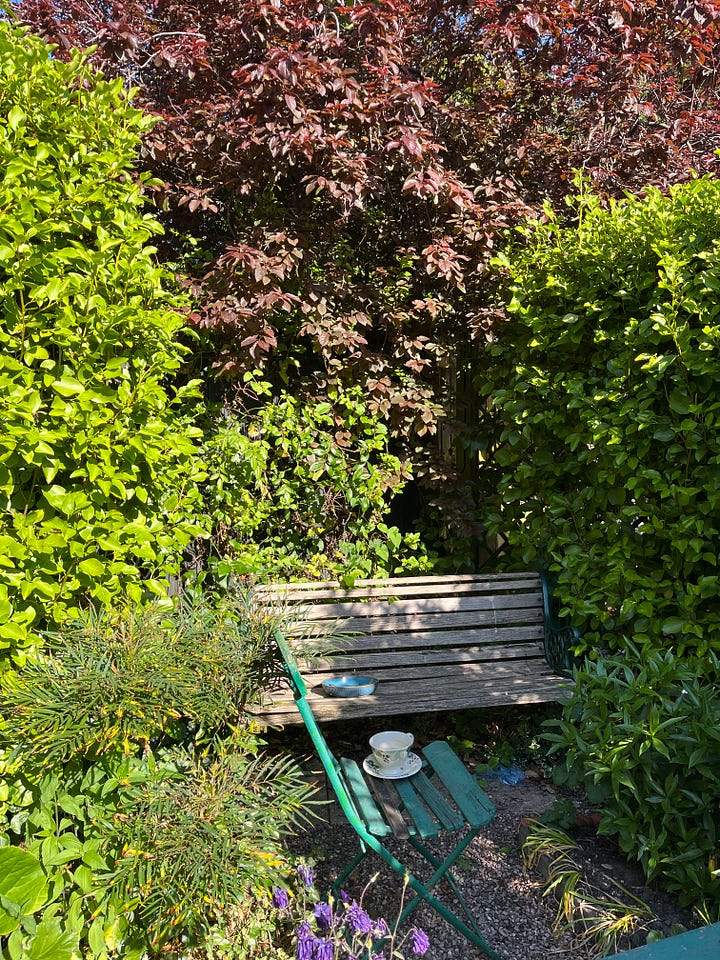


Dreaded beast AcMo, Acanthus Mollis, has an ugly case of developing mildew on the lower leaves, which are now almost white. Up above, it is still looking healthy so I’m leaving it for now, simply cutting off the worst below. Later, I will probably cut it to the ground because it will grow again and that may result in summer growth without mildew.
Moving on from AcMo, I notice that there’s a large soft shield fern, Polystichum Setiferum, waiting to be replanted. There were three big, beautiful ferns in this dark bed but one of them was in the wrong position. I wanted them triangularly symmetrical, spinning around the centre, so during the winter, I dug one of them out, and it’s been sitting in a plastic bucket waiting for me to take action ever since.
I have been removing pink and white aquilegias over the last few years to make sure that I only get the dark blue, beautifully bonneted types. And there, just where I wanted fern-in-bucket to go, was a large, pinky white Aquilegia. So in went the spade, out came the Aquilegia, and it only needed a little more digging to make a hole big enough to take the fern.
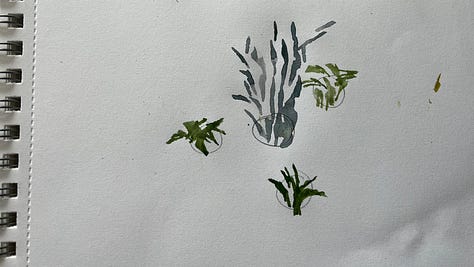
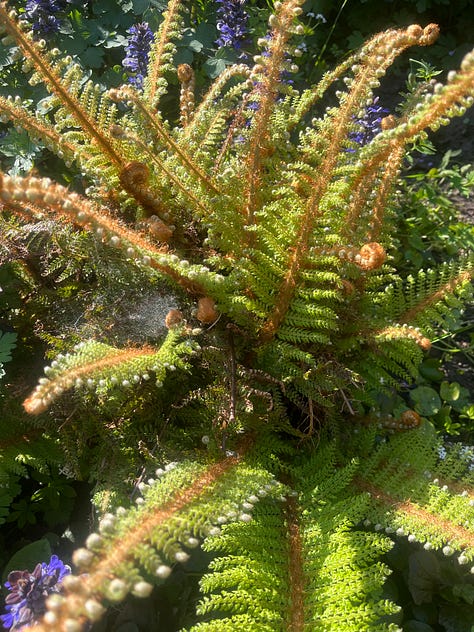
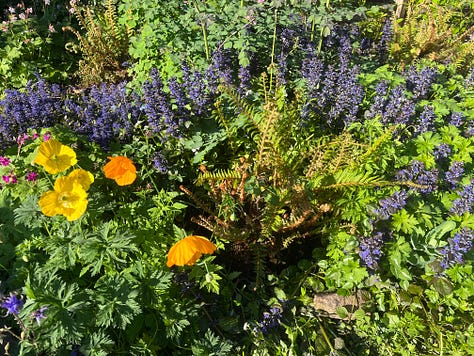
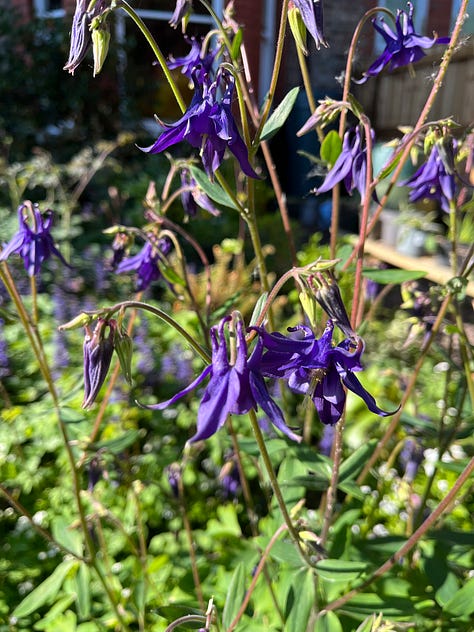
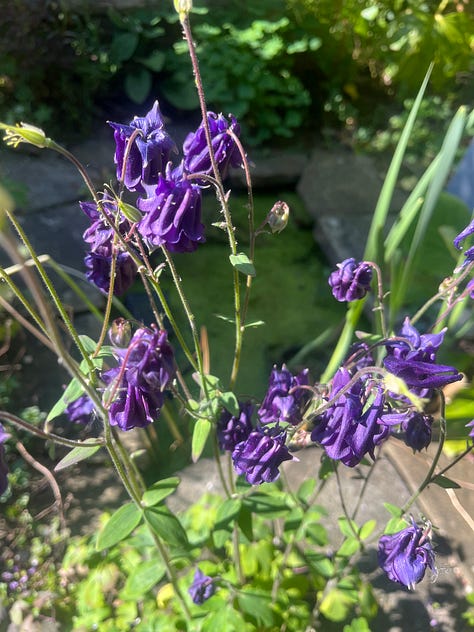
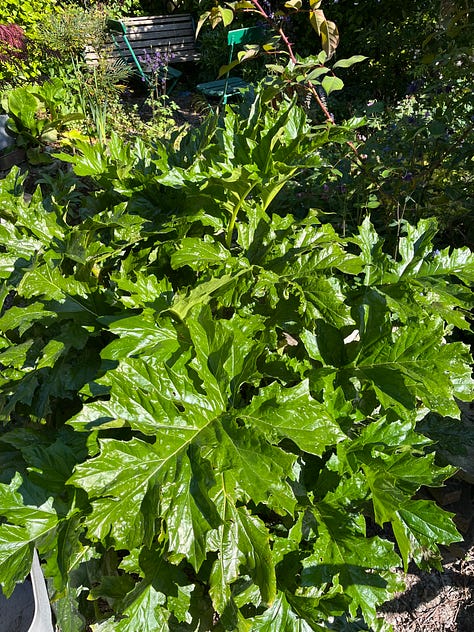
Top Row - Sketch in notebook of three ferns circling Thalictrum: fern unfurling: fern in hole.
Bottom Row: Aquilegia Blue, pixie hat style: Aquilegia Blue, Victorian Bonnet style: AcMo looking not to shabby from above.
Outcome of this action was the smashing up a few of the Ajugas, but they will renew themselves very quickly.
Dark Bed is absolutely buzzing with hoverflies and other pollinators, from tiniest pin-prick size creatures, to big, and various, bees. Every bee-loving body should be planting these Ajugas. They’re no trouble! They cover a lot of ground! You can get rid of them easily if need be, and these blue spikes are a haven for many types of pollinators.
As I eat breakfast, I’m thinking, when I go to Allotment, I need to look for some sticks to create some kind of support structure for Thalictrum.
Sunday: Here Be The Giants!
Dark Bed, Front Garden, top right hand side as you walk towards house, is as lovely as can be at the moment, because of Ajuga Reptans Caitlin’s Giant. It’s an Ajuga, Jim, but not as we know it. It is very big, and very beloved by bees.
I was out there early again, this morning building a support for the also rather large Thalictrum ‘Elin’ - which can grow up to 9 feet (270cms) tall.
When I see photos of ‘Elin’ on nursery websites, (wonderful Ballyrobert is where I got mine from) they are just standing there, upright but hazy, like stoned, stick-thin hippy models in fluffy-fringed crochet crop-tops.
Ah, in the catalogue they look as if there were no need for support, but for me, in Dark Bed, last year, where I placed them centre stage, they grew up for a while, then staggered forward toward the light, craning, leaning hard, like stick thin models in a Force 7 gale, until they became fixed at a drunk but unhappy 45• angle, and I had to prop them up with a couple of forked sticks. Despite the fluffy crop-tops, not a good look.
Always, says every garden expert, put your supports in place before they are needed. And this year, though I could have been earlier, I have done that, or I’ve at least done better and sooner than last year.
These same experts say ‘twiggy pea-sticks’ and ‘brushwood’. And I say, ‘Yeah, yeah… where do you get that stuff?’
And seriously, where, if you are an urban or suburban gardener without ‘brush’ or ‘wood’, without birches, without a hazel coppice, do you get it?
You could go out by the light of the moon with a pal to help you heave your Birch into an estate car and make your twig-in-driver’s-eye getaway, and if you do, don’t forget some stout secateurs, some industrial strength loppers, and a pair of head-torches.
You could cut your ‘brushwood’ from some waste ground, if your local waste ground has anything more than buddleias and discarded Nitrous Oxide bulbs growing on it.
You could, but I never have. I just read about twiggy pea-sticks in books written by people with a lot more garden than me and tut grumpily and reach for the bamboo or metal supports.
Until last year, when one of the Woodland Rangers told me it was ok to take some of the birch and he and the volunteers had felled and stacked, near the public car park, up on the hill, as part of the conservation plan. No head-torches needed. We did it quite openly, in daylight.
And I now have a further source - the park workers’ pile of stuff, destined for commercial composting, at the Allotment site. This pile doesn’t always have twiggy pea sticks and brushwood, but this week it did and so I brought a load home yesterday (you do need the estate car) to construct supports for various plants, including Thalictrum ‘Elin’.
Ground Cover
Like ‘twiggy pea sticks’, the phrase ‘good ground cover plant’ used to annoy me when I was a more novice gardener. Why would anyone want to cover the ground? Surely, you’d just put plants you like in and they would cover it? It sounded a lazy and can’t be bothered way of going about things. Just get some ‘ground cover’. Cover it up. A step up from plastic grass.
About all that I was wrong, wrong, wrong.
You look for plants you love, and that includes trees and shrubs, and perhaps fills about a half or maybe two thirds of your garden (I’m thinking of my own at the moment, after twenty odd years of gardening). These things you love cover only so much, and then you have patches of bare soil in between, and those patches become places where weeds very happily, very quickly, and very strongly grow. (See photo above where Ajuga ‘Chocolate Chip’ hasn’t yet covered all the bare soil.) So ‘ground cover’ isn’t just about ‘cover’ but also about prevention of weedy chaos.
Perhaps a reason I was against ground cover was that one of the ground cover plants I inherited or was given was Vinca major - periwinkle. You know it. Shiny ovate leaves, bright blue/violet, or sometimes white, flowers. Strong.
Strong, stringy stems that get everywhere, looking like abandoned twiny knitting. For me - few leaves and fewer flowers, mainly the stringy stems. Whenever I see it now, I pull it out.
I would like to see it grown well, where it looks great, where anyone would say, ‘Wow! look at that Vinca!’ but I’ve never had that experience. (Though very slightly tempted by a lovely and unusual form sold by the estimable Shire Plants.)
But if that’s ground cover I’d rather have uncovered ground, I thought, early on in my gardening life. I’d rather have Green Alkanet, which at least flowers really well and feeds a lot of pollinators.
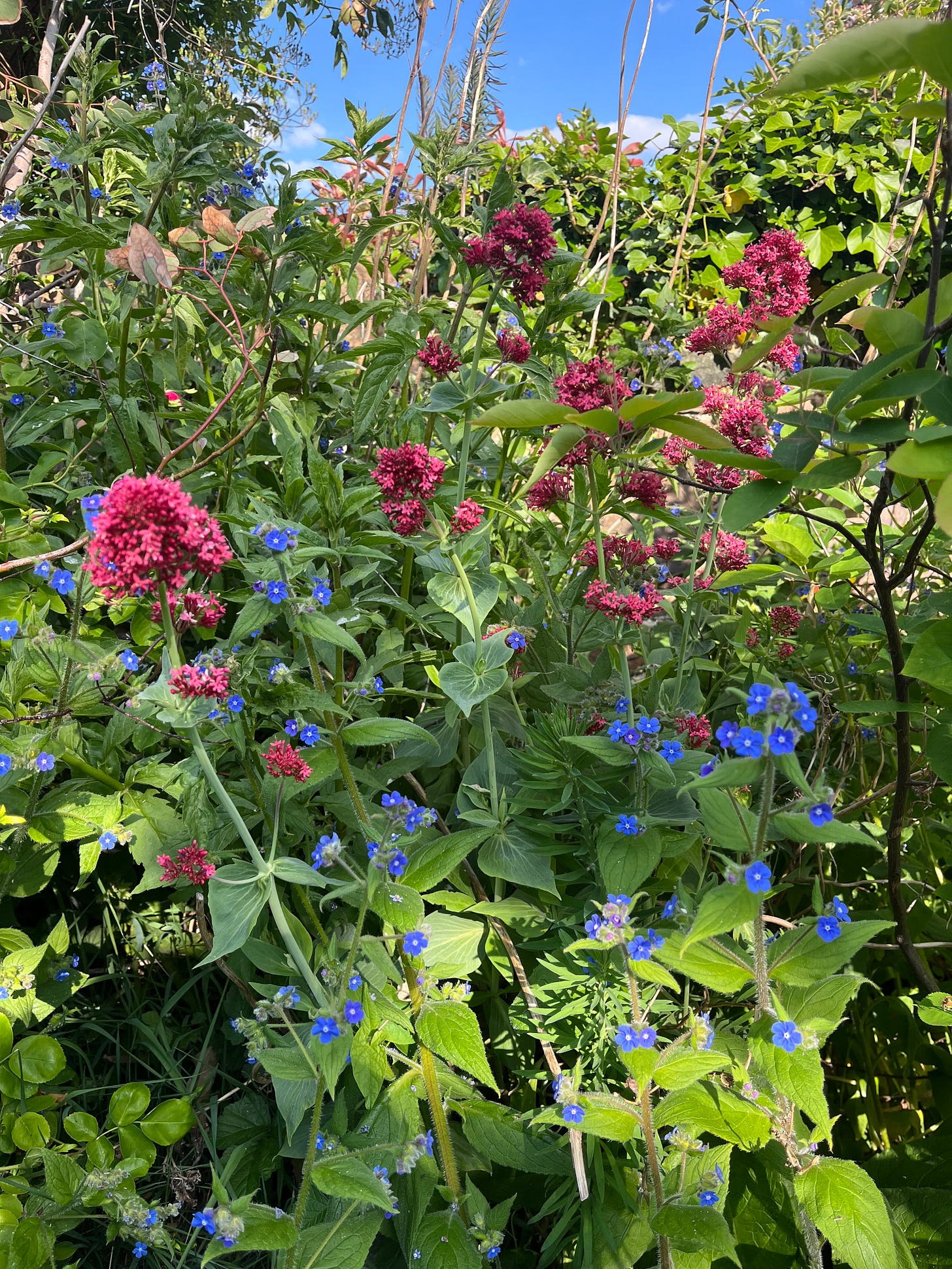
And then I saw my neighbours back garden from one of our upstairs windows and there was this beautiful sheet of coppery glossed leaf and an upright blue-ish violet flower… ‘What’s that?’ I asked her. ‘Ajuga,’ she told me, ‘great ground cover.’ Wise lady.
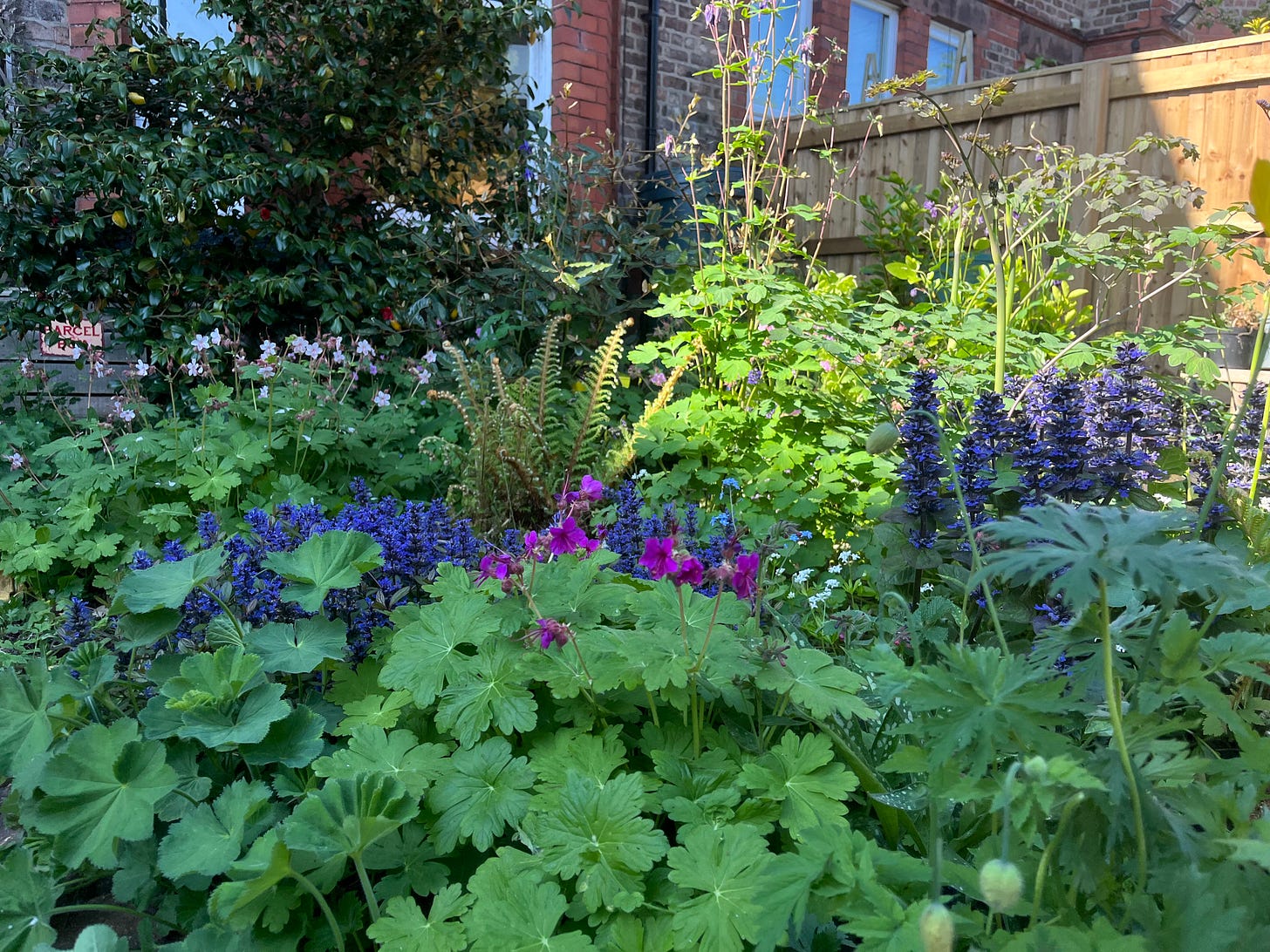
The beauty of Ajuga, whether giant or otherwise, is that it spreads by runners, which you can easily pull-out, pot up and give to your friends and neighbours. Spread the bee-love. In Dark bed, it looks particularly attractive with several Hardy Geraniums, more of which will come into flower later. They, too, can easily be dug out and given away when they get unruly. There are so many varieties of Hardy Geranium, my first gardening love, and I will write up some of my favourites in another post.
If I can identify them.





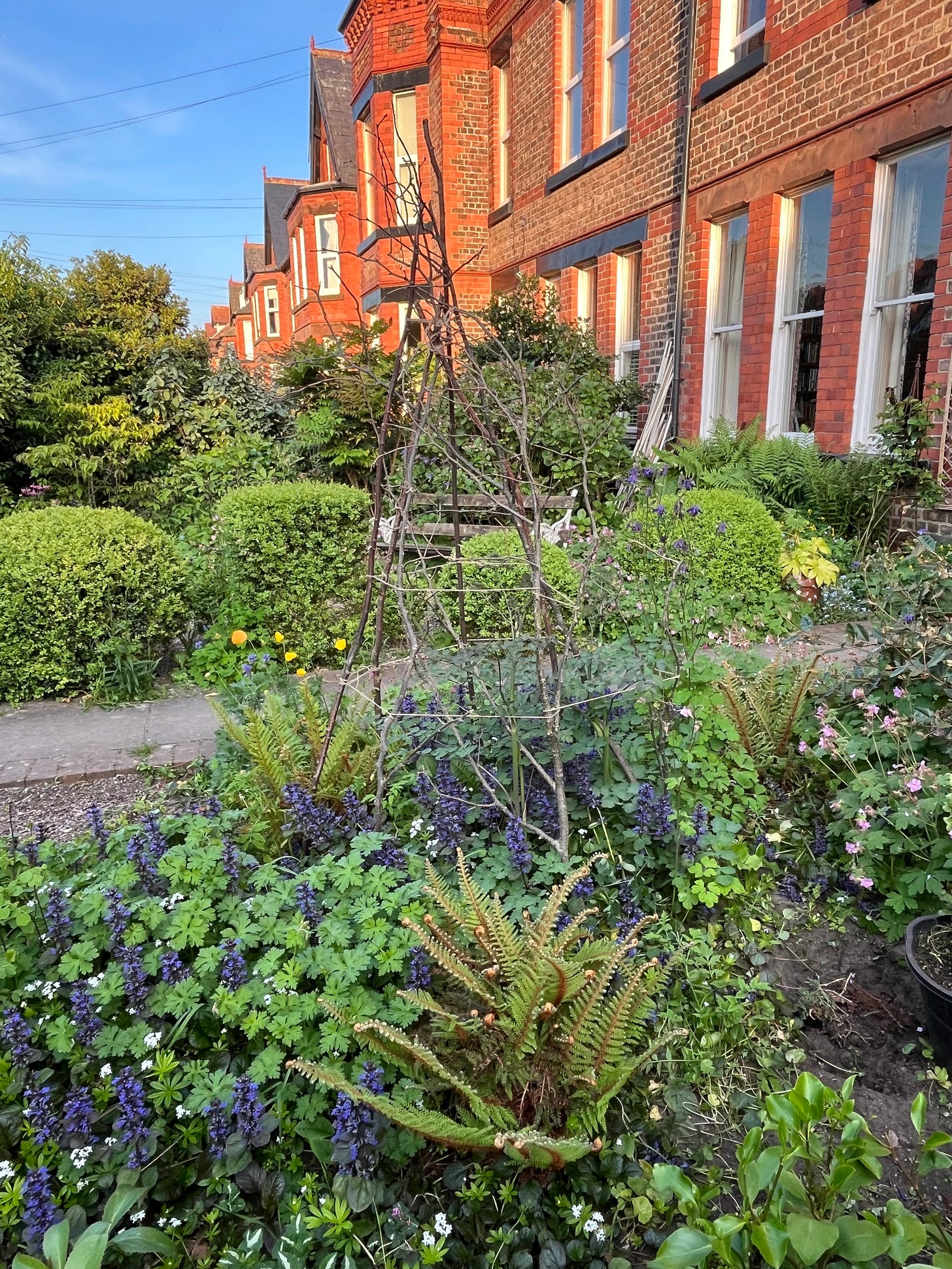
Bare earth is very stressful to look at, let alone what it must be like for the plants baking in it, especially in this dry spring. I am semi-tempted by Ajuga, but hesitant about it escaping into the adjacent lawn. I'm looking for a replacement for Sweet Woodruff in a dry border under trees. The Sweet Woodruff was far too invasive, and didn't seem to have the redeeming factor of attracting bees.
Set against a bus only once an hour, no easy access to libraries, art galleries, concerts or John Lewis, being able to walk 10 minutes and find birch branches for the taking is one of the plus points of living in the country.
Such a lovely post to read this morning. "Umbrageous" is such a gorgeous word - thank you! I like the idea of giant ajuga too, although the ground one has never flourished for me either, though I love that intense blue.